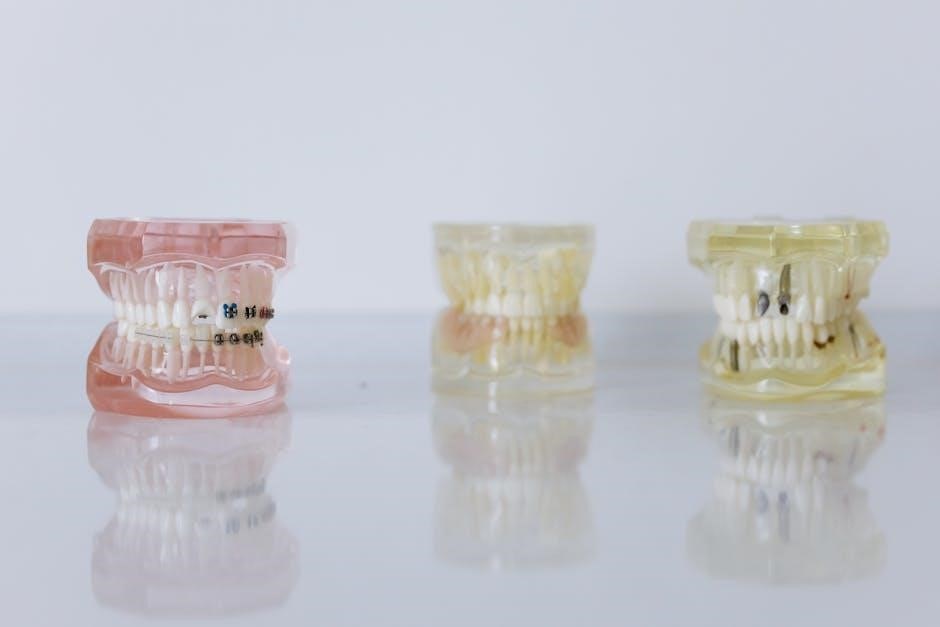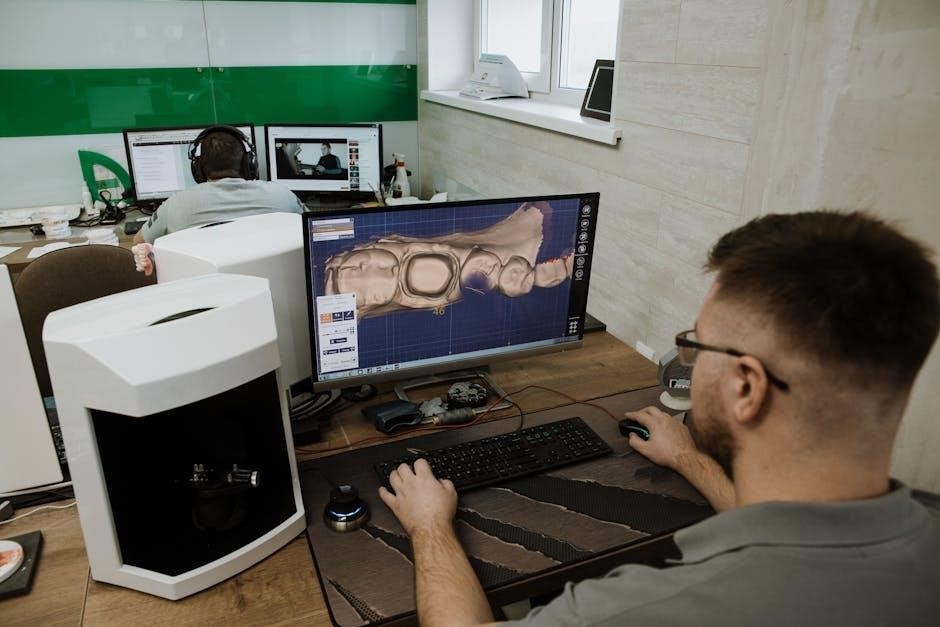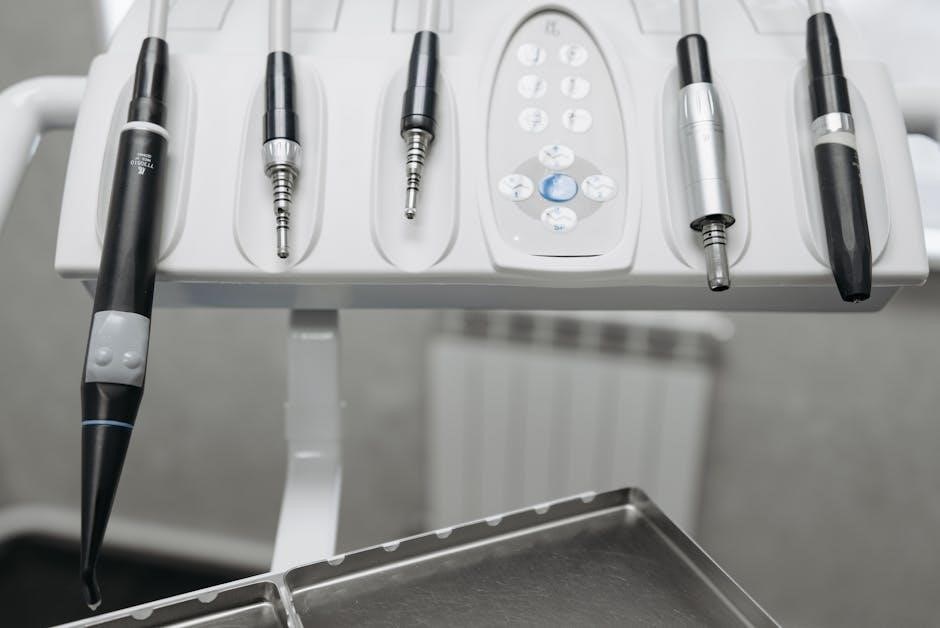Post-operative instructions are crucial for recovery, providing guidelines to minimize complications and ensure proper healing. Following these steps aids in achieving the best outcomes.
What Are Dental Implant Post-Op Instructions?
Dental implant post-op instructions are detailed guidelines provided to patients after implant surgery to ensure proper healing and minimize complications. These instructions cover aspects such as managing bleeding, swelling, and pain, as well as dietary restrictions and oral hygiene practices. They also advise on avoiding activities that could dislodge the implant, such as smoking or chewing hard foods. By following these instructions, patients can promote osseointegration, prevent infection, and support the long-term success of their dental implants. Adhering to these guidelines is essential for a smooth and uneventful recovery process.
Why Are Post-Op Instructions Important for Dental Implant Success?
Post-op instructions are vital for dental implant success as they guide patients through the critical healing phase. Proper care ensures osseointegration, where the implant fuses with the bone, is achieved effectively. These instructions help prevent complications like infection, implant dislodgement, and prolonged recovery. By minimizing bleeding, swelling, and discomfort, patients can resume normal activities sooner. Adherence to these guidelines significantly reduces the risk of implant failure, ensuring a stable and functional restoration. Compliance with post-op care is essential for achieving optimal results and maintaining the longevity of the implant.

Understanding the Healing Process After Dental Implant Surgery
The healing process after dental implant surgery involves osseointegration, where the implant fuses with the jawbone over several months, ensuring stability and durability for the prosthetic tooth.
The Timeline of Healing and Osseointegration
The healing timeline begins immediately after surgery, with initial recovery lasting 1-2 weeks. Osseointegration, the process where the implant integrates with the bone, typically takes 3-6 months. During this period, the bone grows around the implant, securing it in place. Factors like bone quality and implant stability influence the duration. Proper post-operative care ensures optimal integration. After osseointegration, the implant is ready for the prosthetic tooth, restoring function and aesthetics. Adhering to post-op instructions accelerates healing and supports long-term success of the dental implant.
Biological Phases of Dental Implant Integration
The biological integration of dental implants occurs in distinct phases. Initially, bleeding and clot formation stabilize the implant. Within days, granulation tissue forms, initiating bone healing. Osseointegration begins, where bone cells attach to the implant surface, ensuring stability. This process typically completes in 3-6 months, depending on bone quality and implant stability. During this period, avoiding mechanical stress is critical to prevent disruption. Once integrated, the implant becomes a permanent part of the jawbone, ready to support a prosthetic tooth. Proper healing ensures long-term functionality and aesthetic success of the implant.

Immediate Post-Operative Care for Dental Implants
Immediate post-operative care involves biting on gauze to control bleeding, avoiding rinsing or spitting, and using ice packs to reduce swelling and promote healing.
Managing Bleeding and Swelling After Surgery
Bleeding after dental implant surgery is normal, with minor oozing often controlled by biting on gauze for 30-60 minutes. Swelling can be managed using ice packs applied intermittently (20 minutes on, 10 minutes off) for the first 48 hours. Elevating the head while resting may also reduce swelling. Monitor for excessive bleeding or swelling, as these could indicate complications. If bleeding persists or swelling increases, contact your dentist promptly. Proper care ensures a smooth recovery and minimizes discomfort during the initial healing phase.
Using Ice Packs and Monitoring Swelling
Apply ice packs to the surgical area for 20 minutes on and 10 minutes off during the first 48 hours to reduce swelling. Frozen peas in a bag can also be used if an ice pack is unavailable. Swelling typically peaks around the second day and subsides by the third. Monitor for excessive swelling, redness, or fever, as these may indicate complications. If swelling persists or worsens, contact your dentist promptly. Proper use of ice and monitoring ensures swelling is managed effectively, supporting a smooth recovery process.
Pain Management and Discomfort Relief
Pain management is essential for a comfortable recovery. Use prescribed or over-the-counter pain relievers like ibuprofen or acetaminophen as directed. Monitor discomfort levels and adjust medication accordingly to ensure healing progresses smoothly and prevent complications.
Recommended Pain Relief Medications
Managing pain is crucial for a comfortable recovery. Over-the-counter medications like ibuprofen (400-800 mg every 6-8 hours) or acetaminophen (500-1000 mg every 4-6 hours) are commonly recommended. For severe pain, prescription narcotics such as hydrocodone or oxycodone may be prescribed. Always follow the dosage instructions provided by your dentist or pharmacist. Avoid combining pain relievers without medical advice. If you have allergies or medical conditions, inform your dentist to ensure safe medication use. Proper pain management helps reduce discomfort, enabling you to focus on healing and recovery effectively.
Managing Discomfort and Soreness
Discomfort and soreness are normal after dental implant surgery. Swelling and tenderness around the surgical site can be managed with ice packs applied for 15-20 minutes at a time. Stick to a soft-food diet, avoiding chewing near the implant site. Gently rinse with warm salt water or antiseptic mouthwash to soothe the area. Rest and avoid strenuous activities to promote healing. Monitor soreness levels, as they typically subside within a few days. If discomfort worsens, contact your dentist to rule out complications. Proper care ensures a smooth recovery and minimizes irritation during the healing phase.

Post-Operative Dietary Restrictions
After dental implant surgery, stick to soft foods like yogurt, mashed potatoes, and smoothies. Avoid hot, hard, or chewy foods that could disrupt healing or cause discomfort.
foods to Avoid in the First Few Days
Foods to Avoid in the First Few Days
Avoid hot, hard, or crunchy foods like nuts, chips, and raw vegetables, as they can dislodge the implant or cause discomfort. Stay away from chewy or sticky foods such as caramel or gum. Acidic or spicy foods should also be avoided to prevent irritation. Do not consume alcohol, as it can delay healing and interact with pain medications. Additionally, avoid sugary foods and drinks to reduce the risk of infection. Opt for soft, cool, and bland foods during the initial recovery period to promote healing and minimize discomfort.
Recommended Soft Foods for Recovery
During the initial healing phase, focus on soft, nutrient-rich foods to minimize discomfort and promote recovery. Opt for foods like yogurt, scrambled eggs, mashed potatoes, and soft-cooked vegetables. Soups, smoothies, and oatmeal are also excellent choices. Avoid foods with seeds, nuts, or hard particles that could irritate the implant site. Ensure meals are bland and not overly spicy or acidic, as these can cause irritation. Staying hydrated with water or herbal teas is crucial. Choose foods that are easy to chew and swallow, allowing your mouth to heal without additional stress or discomfort.

Oral Hygiene During the Healing Phase
Gentle cleaning around the implant site is essential to prevent infection. Use an antiseptic mouthwash as directed and avoid brushing the surgical area initially. Soft-bristle toothbrushes can gradually be introduced once tenderness subsides, ensuring proper oral hygiene without disturbing the healing process.
How to Clean the Implant Site
Keep the implant site clean to promote healing and prevent infection. Avoid disturbing the surgical area for the first few days. Gently rinse with a saline solution or prescribed mouthwash, as directed by your dentist. After 24-48 hours, use a soft-bristle toothbrush to clean the area, being cautious not to apply too much pressure. Avoid using harsh toothpaste or abrasive products. Instead, focus on gentle, light strokes to remove plaque and bacteria. This careful cleaning routine will help maintain a healthy environment for proper healing and osseointegration of the implant.
Using Antiseptic Mouthwashes
Antiseptic mouthwashes are essential for maintaining oral hygiene after dental implant surgery. Use a mouthwash prescribed by your dentist, such as chlorhexidine, to reduce bacteria and prevent infection. Swish the solution gently around your mouth for 30 seconds, then spit it out. Avoid rinsing vigorously or using harsh products. Continue this routine as directed, typically for 7-10 days. This helps protect the implant site and promotes a healthy recovery, ensuring the implant integrates successfully with the surrounding tissue.

Avoiding Mechanical Stress on the Implant
Avoid chewing hard objects or applying force on the implant site to prevent dislodgement. Refrain from using the implant for biting or tearing during healing.
Preventing Implant Dislodgement
To prevent implant dislodgement, avoid chewing on hard objects or applying excessive force on the implant site. Refrain from using the implant for biting or tearing during the initial healing phase. Avoid sticky or hard foods that could disrupt the implant. Do not disturb the surgical site with your tongue or fingers. Keep the area clean with a soft toothbrush and antiseptic mouthwash as directed. Following these guidelines helps ensure proper osseointegration and long-term stability of the implant.
Activities to Avoid During Recovery
During the recovery period, it is essential to avoid activities that may disrupt the healing process. Refrain from vigorous rinsing, spitting, or using straws, as these can dislodge the blood clot. Smoking should be avoided to prevent delayed healing and complications. Avoid heavy lifting or strenuous exercises that could increase blood flow to the surgical site. Do not wear removable dentures near the implant area until advised. These precautions help protect the implant and promote a smooth recovery.

Smoking and Alcohol Consumption After Surgery
Smoking and alcohol consumption after surgery can hinder healing, reduce blood flow, and increase the risk of complications. Both should be avoided to ensure proper recovery.
The Impact of Smoking on Healing
Smoking significantly impairs the healing process after dental implant surgery by reducing blood flow and introducing toxins like nicotine and carbon monoxide. These chemicals damage blood vessels, delaying recovery and increasing the risk of complications. Smoking also weakens the immune system, making it harder for the body to fight infections. Additionally, it interferes with osseointegration, the critical process where the implant fuses with the bone. Continued smoking can lead to implant failure and long-term issues like peri-implantitis. Patients are strongly advised to avoid smoking during the healing phase to ensure proper recovery and implant success.
Alcohol Consumption and Its Effects
Alcohol consumption after dental implant surgery can hinder the healing process by increasing inflammation, slowing recovery, and raising the risk of complications. Alcohol thins the blood, potentially leading to excessive bleeding, and can also irritate the surgical site, causing discomfort. Furthermore, alcohol can interact negatively with prescribed pain medications, reducing their effectiveness and increasing the risk of side effects. Patients are advised to avoid alcohol during the initial healing phase to promote proper recovery and minimize risks to their dental implant’s success and overall oral health.

Monitoring for Post-Operative Complications
Monitor for signs of infection, such as fever, swelling, or pus, and contact your dentist if symptoms worsen or persist. Timely intervention ensures optimal recovery;
Signs of Infection or Failure
Signs of infection include increased swelling, redness, pus, or a bad taste. Implant failure may present as loosening or mobility. Contact your dentist immediately if these occur.
When to Contact Your Dentist
If you experience excessive bleeding, severe swelling, or pain that worsens despite medication, contact your dentist. Other signs include redness, pus, or a bad taste, which may indicate infection. If the implant feels loose or mobile, seek immediate attention. Additionally, if unusual symptoms like fever or chills develop, or if healing seems delayed, reach out to your dentist. They are available to address any concerns and ensure proper recovery. Don’t hesitate to contact them if something feels abnormal or worrying.

Follow-Up Appointments and Check-Ups
Regular follow-ups are essential to monitor healing, ensure implant stability, and address any concerns. These visits allow your dentist to assess progress and confirm proper integration.
The Importance of Regular Check-Ups
Regular check-ups ensure proper healing and long-term success of dental implants. They allow dentists to monitor osseointegration, check for any signs of complications, and confirm the implant’s stability. Early detection of potential issues can prevent more serious problems from developing; During these visits, your dentist may evaluate the implant’s integration with the bone, assess the surrounding tissue health, and ensure that the implant is functioning as intended. Consistent follow-ups are vital for maintaining the health and longevity of your dental implants, ensuring they remain a stable and functional part of your smile for years to come.
What to Expect During Follow-Up Visits
During follow-up visits, your dentist will examine the implant site to assess healing progress and ensure proper integration with the bone. They may take X-rays to evaluate the implant’s position and stability. The dentist will also check for any signs of complications, such as inflammation or infection, and address any concerns you may have. These visits are crucial to confirm that the implant is healing as expected and to provide guidance on the next steps in your recovery. Regular follow-ups ensure that your implant remains healthy and functional, paving the way for the final restoration phase.

Long-Term Care and Maintenance of Dental Implants
Long-term care involves regular dental check-ups, good oral hygiene, and avoiding smoking or excessive mechanical stress to ensure the implant remains stable and functional for years.
Proper Oral Hygiene Practices
Good oral hygiene is essential for the longevity of dental implants. Avoid brushing the surgical site for the first few days, then gently clean with a soft toothbrush. Use antiseptic mouthwashes as directed to reduce bacteria. After healing, maintain regular brushing and flossing to prevent plaque buildup. Regular dental check-ups ensure the implant remains stable and functional. Proper hygiene practices promote healing and prevent complications, ensuring your implant lasts for years.
Regular Dental Check-Ups for Implant Longevity
Regular dental check-ups are vital for maintaining the health and longevity of dental implants. Scheduled visits allow your dentist to monitor osseointegration and ensure proper healing. They can detect early signs of complications, such as loosening or infection. Professional cleanings help remove plaque and tartar, preventing issues like peri-implantitis. Regular exams also ensure the implant’s stability and function. By adhering to recommended check-ups, you can ensure your implant remains a durable and lasting solution for your smile.
Adhering to post-op instructions ensures proper healing and long-term success of dental implants. Regular check-ups, proper care, and patience are key to achieving optimal results.
Key post-op instructions include managing bleeding with gauze, using ice packs to reduce swelling, and avoiding hot foods/drinks until anesthesia wears off. Stick to a soft diet initially, avoid smoking, and refrain from disturbing the surgical site. Gentle oral hygiene practices, such as using antiseptic mouthwash, are essential. Avoid mechanical stress on the implant and monitor for signs of infection. Attend follow-up appointments to ensure proper healing and osseointegration. Adhering to these guidelines will promote a smooth recovery and long-term implant success.
Final Tips for a Successful Recovery
For a successful recovery, prioritize rest and avoid strenuous activities. Keep the surgical site clean with gentle brushing and antiseptic rinses. Stay hydrated and maintain a balanced diet, focusing on soft, nutritious foods. Avoid smoking and limit alcohol consumption, as these can hinder healing. Monitor for signs of complications, such as increased pain or swelling, and contact your dentist promptly if concerns arise. Attend all scheduled follow-ups to ensure proper healing and implant integration. By following these tips, you can ensure a smooth recovery and optimal results for your dental implant.